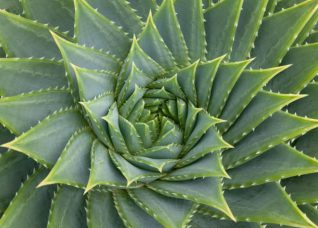
MinerAlert

MinerAlert
Aloe spp.
Asphodelaceae
Aloe vera, Babosa, Barbados aloe, Cape aloe, Curaçao aloe
Sábila, Zábila.

There are more than 400 different species of Aloe, but the ones that are more commonly used commercially include: A. vera, A. barbadensis and A. capensis or “Cape Aloe”. The majority of them are native to Africa and the Arabian Peninsula. Several species of aloes have been used for centuries in traditional medicine in Europe, Africa, and Arabia (Johnson 1999; Mabberley, 2017; vanWyk and Wink, 2017). A. vera is possibly one of the most commonly used medicinal plants in the world (Reynolds, 2003; Park and Lee, 2006). Various species of aloes were originally brought to America by the Spanish explorers in the sixteenth century and there are currently several Aloe plantations in various countries around the world, including the United States (van Wyk and Wink, 2017).
The leaves. The clear gel and the yellowish latex are both contained in the leaves, although each product has a distinct chemical composition and a different therapeutic application (Veitch et al., 2013).
The clear gel (known commercially as the “juice”) is scraped from the leaf and can be applied directly to the skin in order to treat scrapes and minor burns. Whole leaf preparations contain both the gel as well as the yellowish bitter juice or “latex”, but should not be taken internally unless under professional supervision and for a limited time (Veitch et al., 2013; van Wyk and Wink, 2017).
The gel is commonly used to treat minor cuts and burns and to help heal wounds. It is also contained in a variety of cosmetics including skin crèmes, lotions, and shampoos. The gel contains a compound known as beta-sitosterol, which promotes wound healing (Park and Lee, 2006).
The gel from the leaves can be useful applied as a poultice to treat scratches or minor skin burns in order to speed up healing. However, Aloe is not useful when applied to deep cuts or wounds, such as those that occur in some surgical interventions. For this reason, it is best to avoid its use in these cases (Park and Lee, 2006; Capasso et al. 2013).
The whole leaf contains the latex, a yellowish liquid with a very bitter taste. Aloe leaves are sometimes taken internally for their laxative and hypoglycemic (blood sugar lowering) properties (Aronson, 2009). Products containing aloe leaves have also been used internally to treat stomach ulcers, diabetes, cancer, gastric ulcers, and to expel intestinal worms (Johnson, 1999; van Wyk and Wink, 2017). However, the use of whole- leaf preparations should be avoided internally, especially during pregnancy and lactation, as well as in prolonged treatments, as they can have a very irritating effect upon the gastrointestinal tract (Mills and Bone, 2005; Aronson, 2009; Veitch et al., 2013 ).
A study isolated different polysaccharides (water-soluble polysaccharide (WAP), acid-soluble polysaccharide (ACP), and alkaline-soluble polysaccharide (ALP)), from the leaves of A. arborescens, in order to assess their in vitro antitumor activity in three different cancer cell lines. Additionally, their potential immune-modulatory activity in vitro was evaluated employing a phagocytosis and lymphocyte transformation assay. The results of the study demonstrated that the WAP and ALP fractions showed the most salient cyto-toxicity activity versus HepG2 human liver cancer cells. These results of this study confirmed the use of the A. arborescens as a potential co-adjunctive supplement for treating cancer patients undergoing immune-suppression during chemotherapy (Nazeam et al., 2017).
Various preliminary clinical studies with aloe extracts have demonstrated their efficacy as palliative therapy in prolonging the survival or improving the quality of life in patients with intractable metastatic cancer (Lissoni et al., 1998).
A Brazilian empirical recipe based on blending whole aloe leaves (especially A. arborescens) with raw honey, and a small quantity of one of various alcoholic beverages (such as whisky or tequila, for example), is stated to be effective in stimulating the immune system, as well as an option for the treatment of various chronic diseases, including cancer (Zago, 2000, 2008, 2009). However, more research based on clinical trials needs to be undertaken to confirm this.
A controlled study undertaken in humans with 50 patients afflicted with lung, gastrointestinal, breast or brain cancer, who were treated orally with melatonin (MLT) alone (20 mg/day in the dark period) or MLT plus A. vera tincture (1 ml twice/day). The tincture was based on an empirical recipe, consisting of 300 g of fresh A. arborescens leaves with 500 g of honey and 40 ml of 40% alcohol, at a dose of 10 ml and taken three times a day. The results of the study showed that the percent for one-year survival was significantly higher in patients treated with aloe plus MLT (Lissoni et al., 1998).
A study evaluated the potential cytotoxic effects of an A. vera crude extract (ACE) alone or in combination with cisplatin in human breast (MCF-7) and cervical (HeLa) cancer cells. The bioactive ingredients present in the extract inhibited the growth of cancer cells, but did not have any deleterious effects upon normal cells. The authors of the study concluded that the plant could be an effective anti-neoplastic agent by inhibiting the proliferation of cancer cells, while augmenting the therapeutic efficacy of certain anti-neoplastic medications, such as cisplatin, for example (Hussain et al., 2015).
Safety/Precautions:
Before you decide to take any medicinal herb or herbal supplement, be sure to consult with your health care professional first. Avoid self-diagnosis and self-medication: Always be on the safe side!